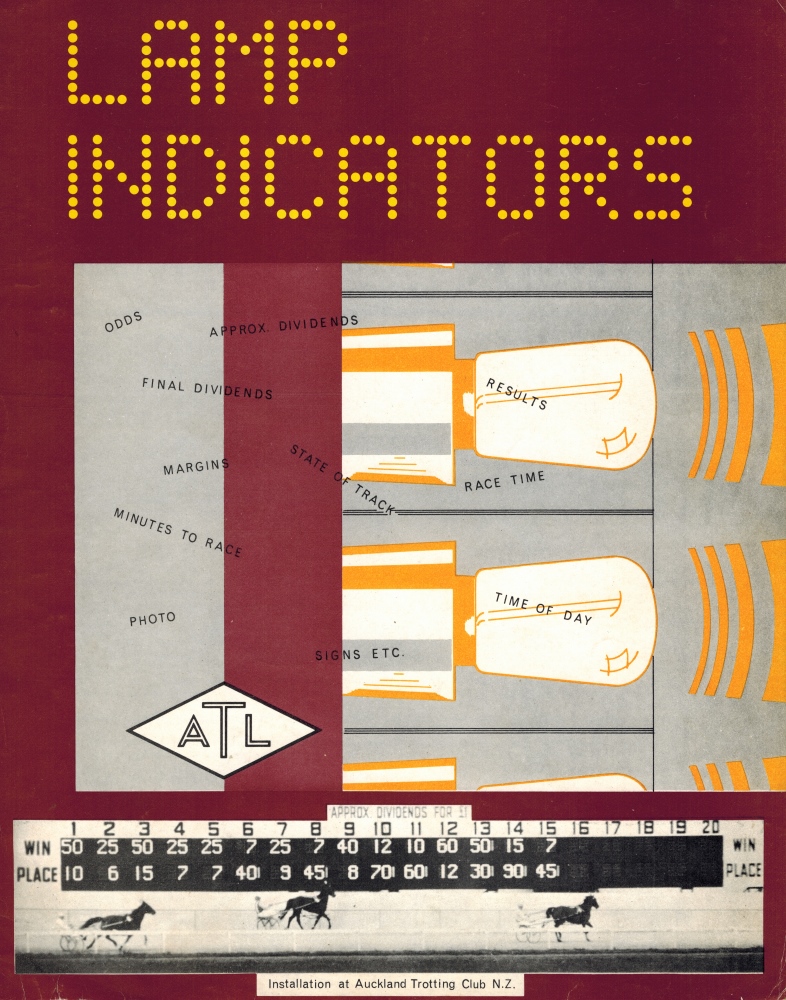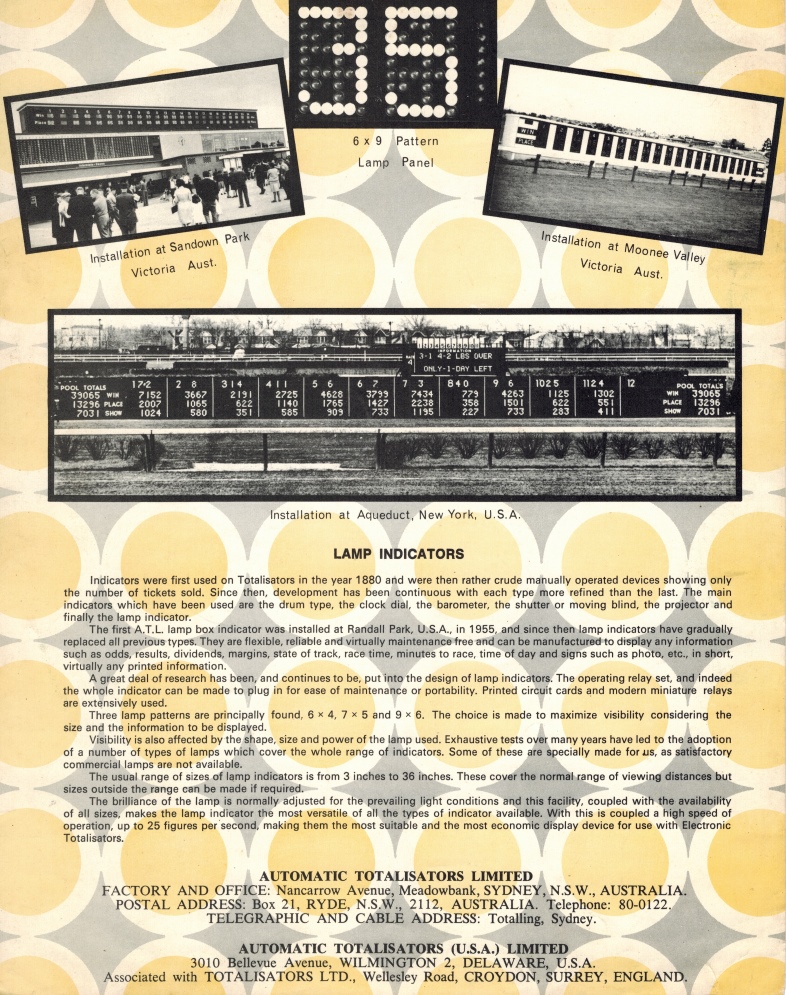This page contains a photograph which is one of several belonging to the photo gallery pages which are part of several technology and company history pages relating to the invention of the world's first automatic totalizator in 1913 and Automatic Totalisators Limited, the company founded to develop, manufacture and export these systems.
Lamp Indicators Brochure Courtesy Chris Robertson
These images show the front and back of the Lamp Indicators Product brochure in the form of an A4 size card. This and other cards like it on this website were provided by Chris Robertson, an ex customer of the company and an expert on its products and installations around the world. This brochure was probably produced in the 1960s. The front of the brochure shows a part of a lamp panel, a unit that provides a single character out of a bulb matrix and many of these units are used to build the front of an indicator. At the bottom of the front, there is a full Win Place Odds indicator at the Auckland Trotting Club in New Zealand with trotters shown in the foreground. More after the images...

Click on the image to go back to the photo gallery
This is the front of an Automatic Totalisators product promotion card

Click on the image to go back to the photo gallery
This is the back of an Automatic Totalisators product promotion card
Regarding the Win Place Odds indicator at the Auckland Trotting Club in the first image, Ian Waugh mentions this indicator in a section titled Ian Waugh's Memories of New Zealand in the Tote Topics chapter of this website. A couple of pertinent extracts follow:
I was employed by ATL at Wanganui NZ in 1963 and worked for the company there and in Auckland until 1982 when the company's NZ assets were purchased by NZTAB. Then worked for TAB until retirement. Mervyn Smith was my immediate superior in Wanganui and then Auckland and we still visit each other when either family "crosses the ditch".
You may already be aware, but in 1963 ATL installed a complete Tote system for Auckland Trotting Club at Alexandra Park. This system had two Lamp box W/P Dividend displays driven from the machine room equipment. This setup lasted until around 1982/83 when TAB installed their Computer equipment. The ATC purchased the Outfield Indicator and Merv and I arranged for an ex-Wanganui post office technician (the late John Ashworth) to design and construct an interface to drive the Indicator relays.
On the reverse side of the brochure, shown above, at centre top are two of the lamp panels mentioned with the illuminated bulbs showing the number 35. These lamp panels are different to the ones I am used to working on, as they had a full matrix of lamps in the lamp panel not ones covering specific lines required for reproducing numbers. The full matrix panels could be used for alphabet characters as well and provided some latitude in the way the alphanumeric characters are formed in the firmware when the hardware controllers became microprocessor based, as the ones of my era were.
Chris Robertson wrote about the lamp indicators in Victoria in the Melbourne Cup chapter of this website under the heading Memories of this Era by Chris Robertson and mentioned the Installations at Sandown Park and Moonee Valley, both shown at the top of the second page. Following are some extracts relating to these installations:
I wrote in an earlier email about my disappointment with the tote odds display at Sydney's metropolitan racecourses towards the end of the ATL era. There are several reasons why Melbourne's metropolitan clubs modernised their totalisator indicator boards in the 1960's that were unique to that place and time.
The most significant was the opening of Sandown Park as a state of the art racecourse in June 1965. In addition to an infield electronic indicator board there were several other lamp indicators around the course, including the double sided one shown in ATL's Lamp Indicators brochure above. One side faced the grandstand enclosure, whilst the other faced the Leger enclosure. The barometer odds display for the Sydney and Adelaide meetings can be seen below the lamp indicator. The Interstate house was built on the border of the two enclosures so that racegoers in the Leger had the same tote facilities as in the Grandstand enclosure. Smaller electronic indicators were installed in the grandstand's undercroft and at the birdcage end of the grandstand. The instillation shown in the ATL brochure still stands at Sandown, though it is many years since it displayed odds. ...
... The ATL brochure also shows an image of a lamp indicator at Moonee Valley. This installation was only visible from the North Hill. The main indicators over the Paddock tote house and at the turn out of the straight (the South Hill) remained as barometer instillations till the computer tote arrived in 1974. The computer tote heralded the arrival of more and larger lamp indicators around Melbourne's racecourses, as well as at ATL provincial operations of Cranbourne, Mornington, Pakenham and Yarra Glen. There were also TV monitors displaying tote odds, but these could only show eight runners at a time, so most racegoers looked at the lamp indicators to check the current state of betting.
Regarding the Installation at Aqueduct, New York, shown in the last image of the back page of the brochure above, there is a description of the whole installation of the Aqueduct Totalisator in the Automatic Totalisators in America chapter of this website under the heading Automation Comes to the Big A. A couple of extracts which mention the Aqueduct indicator shown above follow:
By May 1965 the system was approaching completion. J11 TIMs were arriving from the factory at Meadowbank which was striving hard to complete the order of 550 on time. Wilmington office was working at top gear, producing cable racks, indicator board and counter cubicles, buying cables and lamp-boxes and tuning TIMs. ...
... Upwards of 100 people were employed on site during the installation period and at this time maintenance personnel were hired and trained. Four American engineers were engaged for central computer control, and their training included, computer programming, fault analysis, maintenance procedures and lectures on that intangible quality known as "Tote know-how". Eighteen Union electricians were screened and hired for raceday selling line control and TIM and Indicator Board maintenance. Selected men were also trained in the maintenance and operation of the standby power equipment.

